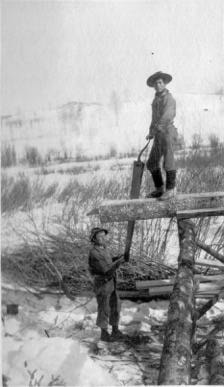Dick Carroll came to Burns Lake in May 1909. After traveling to the head of navigation on the Skeena River, he followed the old Yukon Telegraph trail east to Burns Lake. He wasn’t planning to stay; Fort George was his original destination, but when he arrived here, he was greeted by one of the area’s two white settlers, telegraph operator Malcolm McKinley.
“There’s going to be a good town here in Burns Lake some day,” McKinley told him confidently. “This a place you can locate.”
Carroll liked the lay of the land, so he staked a piece in what is now the Village of Burns Lake. He and Mickey O. Stitch carried the mail from Telkwa to the area’s first post office (located in McKinley’s telegraph cabin on what is now Richmond Loop). He also worked for a time with Amross Blaney.
Carroll is credited with establishing the area’s first sawmill. He and another man, Bazel Tom, used a whipsaw to cut lumber for himself and others.
Whipsawing building materials in this manner was difficult. The saws, which featured a handle on each end, were heavy and up to 14 feet long. While one man could (in a pinch) do the work, whipsawing was generally a two-man operation.
To accommodate the saw’s length and weight, a pit was often dug and a frame built over it to hold the log destined for processing. (Alternatively, a high trestle could be constructed above the ground and the log placed atop it.) One individual, called the ‘pit man’, positioned himself below the log, while the other (the ‘top man’) stood on the frame above. Each then grasped one of the saw’s handles, and together, they worked it through the length of the log. Because the saw’s teeth were angled and filed to cut only on the down stroke, the top man generally did most of the actual ‘sawing’, while the pitman was expected to help lift the saw’s weight on the upstroke and occasionally spell off his partner.
The system worked well if the two men found their rhythm. If they didn’t, it was a long and frustrating process. If the pit man failed to do his part, his partner above grew fatigued and suffered back strain. The pit man, meanwhile, had to endure a downpour of sawdust – and, if he wasn’t helping lift the saw to his workmate’s satisfaction, a steady stream of verbal abuse.
Old-timers will tell you that extended periods of whipsawing ended more than a few friendships. Sometimes, the participants even came to blows.
Carroll and Tom must have worked reasonably well together, because they cut lumber in this manner for some time. The exercise didn’t discourage Carroll from sticking around, either; he later pre-empted 500 acres between Decker Lake and Palling, giving his original Burns Lake homestead to his brother Bill – who later turned much of it over to the municipality.
© 2018 Michael Riis-Christianson and the Lakes District Museum Society
